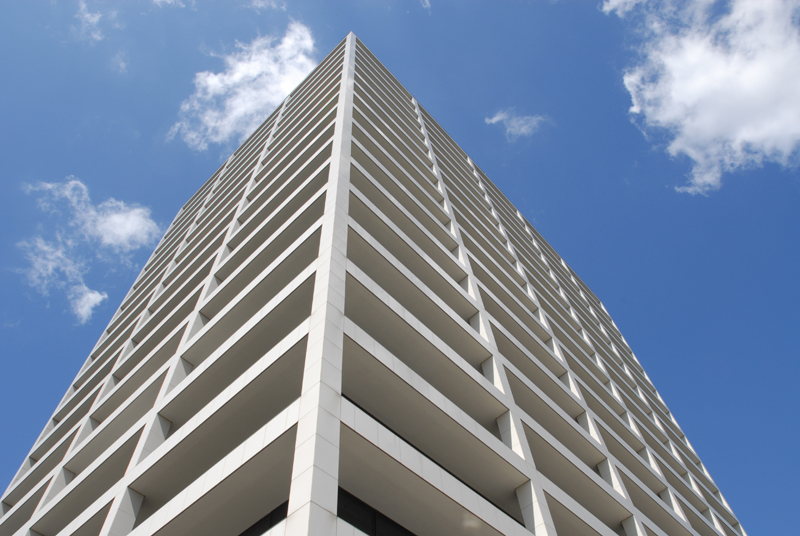In Kansas City, Missouri, One Park Place building, formerly known as the BMA Tower, has been a landmark since Skidmore, Owings & Merrill (SOM) designed it in 1961. Originally office headquarters, the converted luxury condominium building rises 19 stories above the heart of downtown and is a visual milestone from nearly anywhere in the city. Its trademark exterior is devoid of ornamental décor, relying on white cladding and black glazing to create a minimalist Miesian aesthetic that has been celebrated in numerous building awards and a special exhibit at the Museum of Modern Art in New York. In 2002, the building was entered into the United States National Register of Historic Places.
For the iconic building to maintain its dramatic presence in the Kansas City skyline for the greater half of the last century and receive its designation as a historic place, it was critical that the building’s understated exterior remain in top condition. This proved challenging in 1985, when the building’s original white marble cladding began to warp from the corners, causing several panels to fall from the building.
To preserve the building’s famed Modernist appearance, Black & Veatch, an engineering, procurement and construction firm out of Overland Park, Kansas, was tasked with replacing the dilapidated marble with an aesthetically similar, yet structurally improved cladding material. The firm selected white Neopariés® crystallized glass ceramic panels from Technical Glass Products (TGP).
Neopariés crystallized glass ceramic panels have a lower thermal expansion rate, meet stricter engineering guidelines and are lighter and stronger than natural stone, making them an ideal cladding material for a building subject to Kansas City’s extreme temperature changes and harsh weather conditions. Aesthetically, the crystallized ceramic panels have a bright, smooth appearance that closely resembles One Park Place’s original marble.
As an added benefit, Neopariés is virtually maintenance free, with high resistance to staining, pollution and graffiti. “I periodically have a crew wash as much of the Neopariés as they can without hanging over the side of the building,” said Mike Gunter, facilities manager, in an earlier company project write-up. “The only other maintenance required is the monitoring of the caulking.”
Today, after more than 25 years, Neopariés crystallized glass ceramic panels are still keeping the exterior of Kansas City’s landmark One Park Place in top form for city residents.
Neopariés is an ideal alternative to stone for interior and exterior walls, interior floors, counters and table tops. It is available in large, flat or curved panels, and may be used in thinner and lighter configurations than marble or granite. When combined with the Neopariés’ stainless steel anchoring system, the crystallized glass ceramic panels can help design teams create applications with enduring beauty.
For more information on Neopariés, along with TGP’s other decorative and architectural glass products, visit tgpamerica.com.
Additional Information
Project: One Park Place
Location: Kansas City, MO
Architect: Skidmore, Owings + Merrill (original), Black & Veatch (retrofit)
Product: Neopariés® crystallized glass ceramic panels
Technical Glass Products
800.426.0279
800.451.9857 – fax
sales@tgpamerica.com
www.tgpamerica.com
Related Stories
| Oct 13, 2010
Community center under way in NYC seeks LEED Platinum
A curving, 550-foot-long glass arcade dubbed the “Wall of Light” is the standout architectural and sustainable feature of the Battery Park City Community Center, a 60,000-sf complex located in a two-tower residential Lower Manhattan complex. Hanrahan Meyers Architects designed the glass arcade to act as a passive energy system, bringing natural light into all interior spaces.
| Oct 13, 2010
Community college plans new campus building
Construction is moving along on Hudson County Community College’s North Hudson Campus Center in Union City, N.J. The seven-story, 92,000-sf building will be the first higher education facility in the city.
| Oct 13, 2010
County building aims for the sun, shade
The 187,032-sf East County Hall of Justice in Dublin, Calif., will be oriented to take advantage of daylighting, with exterior sunshades preventing unwanted heat gain and glare. The building is targeting LEED Silver. Strong horizontal massing helps both buildings better match their low-rise and residential neighbors.
| Oct 6, 2010
Windows Keep Green Goals in View
The DOE's National Renewable Energy Laboratory has almost 600 window openings, and yet it's targeting LEED Platinum, net-zero energy use, and 50% improvement over ASHRAE 90.1. How the window ‘problem’ is part of the solution.
| Aug 11, 2010
Using physical mockups to identify curtain wall design flaws
Part two of a five-part series on diagnosing and avoiding cladding, glazing, and roofing failures from building forensics expert IBA Consultants.
| Aug 11, 2010
AAMA leads development of BIM standard for fenestration products
The American Architectural Manufacturers Association’s newly formed BIM Task Group met during the AAMA National Fall Conference to discuss the need for an BIM standard for nonresidential fenestration products.
| Aug 11, 2010
AIA Course: Enclosure strategies for better buildings
Sustainability and energy efficiency depend not only on the overall design but also on the building's enclosure system. Whether it's via better air-infiltration control, thermal insulation, and moisture control, or more advanced strategies such as active façades with automated shading and venting or novel enclosure types such as double walls, Building Teams are delivering more efficient, better performing, and healthier building enclosures.












